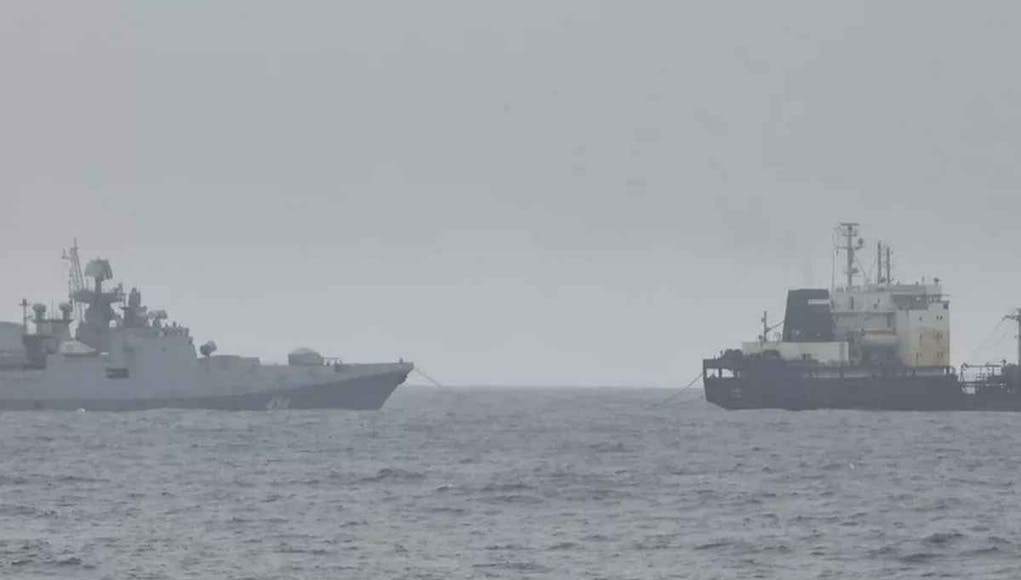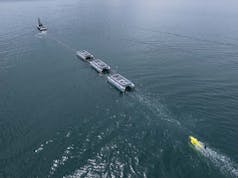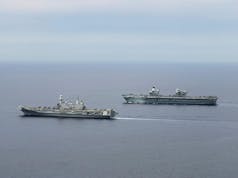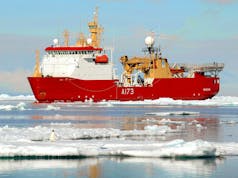A Russian Black Sea Fleet frigate was spotted off the south-west coast of Ireland, marking the latest in a series of Russian naval activities in international waters near Irish territory.
The Frigate Admiral Grigorovich was one of four Russian ships observed by the Irish Defence Forces within Ireland’s exclusive economic zone (EEZ) late last week.
The fleet also included an auxiliary tanker, the Kama, which was seen refuelling the warship within the international waters.
The Irish Air Corps and the navy have been monitoring the flotilla; however, their capacity to do so has been significantly hindered by a severe personnel shortage, which has resulted in many vessels being docked in Cork harbour in recent months.
The Frigate Admiral Grigorovich is equipped for electronic warfare and armed with Kaliber missiles, which have been used to target civilian areas and infrastructure in Ukraine.
In response to these naval activities, both the British Royal Navy and the Royal Air Force have been providing support by tracking Russian navy ships operating in international waters near Irish and British territories.
This collaboration demonstrates the commitment of the UK to safeguarding the maritime security of both nations.
The Irish Defence Forces have confirmed that the four vessels were “monitored by the Irish Defence Forces during the conduct of air and naval patrols and have since departed the Irish EEZ.”
Defence analysts suggest that these high-profile naval activities may serve to intimidate and harass Western governments and coalitions as the conflict in Ukraine continues. There are also concerns about the potential threat to critical infrastructure, such as data and communication cables connecting North America, Ireland, and Europe, which pass off the south-west coast of Ireland. Any damage or interference with these cables could result in severe economic and practical consequences. The ongoing cooperation between Irish and British forces aims to mitigate these risks and maintain regional security, while respecting the legal rights of nations to operate in international waters.














This looks to be part of the group of ships that the Mirror described as an “armada” in the North Sea 3 days ago tracked by the RAF and RN. Then it was the Admiral Grigorovich, the corvettes Sbrazitelnyy, Stoikiy and Odintsovo, along with the tug Grebelsky and tanker Kama.
The Admiral Grigorovich, which was operating out of Tartous when Turkey closed the Bosporus, may be heading to either Northern or Baltic fleet docks for maintenance beyond the abilities of the Syrian port.
Says a lot about the faith the Russians have in their ships when they need to be accompanied by a tug lol
JIMK:
The Dutch Naval military website Marineschepen(dot)NL knocked out a short synopsis on the very subject a week ago. As its a Dutch website, its in Dutch but most browsers are able to translate into English. Well worth a butchers. Ive included a translated transcript (thanks google) from the above linked webpage:
it is a bit odd how the western press changed the name of one of the weasels. It is “Soobrazitelnyy” not “Sbrazitelnyy”, which means one of variants of “smart” in Russisn
It is rare that we get an extra bank holiday in this country. For those who are enjoying it and have a sense of humor, the following Youtube video may amuse
https://www.youtube.com/watch?v=2Z5rcHyuEJs
Talk about the Irish taking on a Russian squadron off their coast. Or us taking on the Russians full stop …..:)
Ho folks hope all is well.
Good to see this level of working together, the cabling under the sea is very important to monitor as this is quit vulnerable. It’s very clear that Russian recent activity around wind turbines and infrastructure are blotting to disrupt.
Also what an opportunity to remind some Irish politicians why the UK supports the Irish military rather than referencing back to some republican rant and rave!
Cheers
George
It’s defence related matters, so pretty much nobody is going to notice in Ireland.
Outside the tabloids the progress of Russian warship in International Waters should be no surprise to anyone.
Ireland really needs to accept, like Sweden and Finland have, that claiming neutrality is no protection from hostile powers. They should bite the bullet and join NATO.
Indeed; as the saying goes all it takes for evil to triumph is that a good man says nothing. Time’s up on opting out of taking a view on post 1917 Russia and other autocratic regimes.
Ireland has hardly any forces ,they need to step up !! They are a prosperous country, get spending !!
Not likely in this generation if not longer, Ireland like Malta, Austria and Cyprus of the EU and Switzerland in the wider Europe will likely stay in some form of “neutrality”.
What people should do, and what they are likely to do, often don’t align.
I said Ireland should, I think it’s unlikely, as stupidity is difficult to argue rationally against.
Nations do what suits them and politicians do what gets them elected/re-elected. Neither of which is close to Ireland joining NATO.
Politicians do a combination of what they believe ideologically possible and what is necessary to get re-elected. Unfortunately Ireland’s politicians are cynical enough to know that NATO would come to its aid if attacked, whilst it doesn’t have to make spending commitments nor a commitment to defending a NATO member if attacked.
It’s a morally bankrupt approach. Ireland’s lack of military help to Ukraine is equally shameful.
Fortunately there does seem some glacial movement, if only on the need for better defences.
https://www.dw.com/en/ireland-rethinks-neutrality-in-wake-of-ukraine-war/a-65330418
It has also suited NATO more than once to have a nation that couldn’t refuse them anyway as other neutral nations can, besides the U.K. and others could easily have refused at any point. As to military support for Ukraine, the answer is with what? Ireland, like the other EU neutrals have been providing funding for equally needed non lethal aid.
As for changes in Irish FP, please don’t waste my time posting links to especially non Irish media on the topic, they mainly miss the point like even the UKDJ random article on buying fighters based off of nothing but a link in a press release, on the equipment plan of a decade old WP.
Martin has called for a public discussion, the Greens will likely splinter on any change on FP cause they are nutters, and SF will play the NATO/Neutrality card and pick up some more votes, nothing major will change.
Do feel free to cite a specific case where “suited NATO more than once to have a nation that couldn’t refuse them”.
Eire could easily buy and supply lethal aid as other non-NATO nations have. It’s a ridiculous stance.
If you weren’t so arrogant to dismiss the media report and actually bothered to read it you wouldn’t make claims about “a decade old WP” that don’t actually appear in the article. The article actually covers events since the start of the Ukraine War.
But given you’re previously displayed inability to differentiate between “should” and “will”, I’m probably wasting my time suggesting you read it.
It is the stance that other nations have taken as well, and is based on political reality.
And you seem to have issues reading, I mentioned weaknesses in foreign reporting as evidence including the UKDJ article that completely misrepresented an issue. Just as the current article you are trying to suggest is something important is actually making something out of nothing.
But yeah as ever you have zero interest in any Irish viewpoint.
Sean, so eloquently put. Ireland would want and probably expect assistance from the likes of the UK if they experienced military hostility. They should remember that
Sweden and Finland soend large amounts on their defensive capabilities – some NATO countries like Canada do not take defense very seriously, relying on US defensive forces. This needs to change.
Won’t happen as they would then have to spend 2% on defence
Hope this small fleet isn’t laying nukes on seabed via some trapdoor . They have consistently shown the tsunami weapon being detonated in Irish seas.
In case you were wondering…
https://www.irishtimes.com/ireland/2023/05/08/secret-anglo-irish-air-defence-agreement-dates-back-over-70-years/
I would be more concerned about the three Russian marine engineering vessels that were off the coast of Kerry and Clare a month ago for almost a week.
Finland when not a member of NATO still had a formidable defence force, Ireland has a nothing force and couldn’t even stop an ancient Viking attack. I love Ireland and the Irish people but some still think the British are the enemy and their government is super useless! I support the Irish and believe the UK’s assistance with their defence is as it should be.
“Ireland spends entire annual defence budget shadowing a russian frigate.”